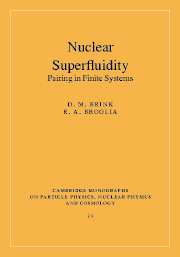Book contents
- Frontmatter
- Contents
- Preface
- 1 Introduction
- 2 The pairing force and seniority
- 3 The BCS theory
- 4 Spontaneous symmetry breaking
- 5 Pairing vibrations
- 6 Phase transitions
- 7 Plastic behaviour of nuclei and other finite systems
- 8 Sources of pairing in nuclei
- 9 Beyond mean field
- 10 Induced interaction
- 11 Pairing in exotic nuclei
- Appendix A A brief résumé of second quantization
- Appendix B Single particle in a non-local potential
- Appendix C Useful relations in the treatment of collective modes
- Appendix D Particle-vibration coupling
- Appendix E Model of the single-particle strength function
- Appendix F Simple model of Pauli principle corrections
- Appendix G Pairing mean-field solution
- Appendix H Pairing in a single j-shell
- Appendix I Fluctuations and symmetry restoration
- Appendix J RPA solution of the pairing Hamiltonian
- Appendix K Vortices in nuclei
- Appendix L Josephson effect
- References
- Index
9 - Beyond mean field
Published online by Cambridge University Press: 17 August 2009
- Frontmatter
- Contents
- Preface
- 1 Introduction
- 2 The pairing force and seniority
- 3 The BCS theory
- 4 Spontaneous symmetry breaking
- 5 Pairing vibrations
- 6 Phase transitions
- 7 Plastic behaviour of nuclei and other finite systems
- 8 Sources of pairing in nuclei
- 9 Beyond mean field
- 10 Induced interaction
- 11 Pairing in exotic nuclei
- Appendix A A brief résumé of second quantization
- Appendix B Single particle in a non-local potential
- Appendix C Useful relations in the treatment of collective modes
- Appendix D Particle-vibration coupling
- Appendix E Model of the single-particle strength function
- Appendix F Simple model of Pauli principle corrections
- Appendix G Pairing mean-field solution
- Appendix H Pairing in a single j-shell
- Appendix I Fluctuations and symmetry restoration
- Appendix J RPA solution of the pairing Hamiltonian
- Appendix K Vortices in nuclei
- Appendix L Josephson effect
- References
- Index
Summary
The Hartree–Fock mean field is represented by a static potential. Non-locality may be approximated by a momentum dependence but the potential is energy independent. In general, independent particle motion is renormalized by coupling to more complicated degrees of freedom. Such couplings often involve a time delay and introduce an energy dependence into the single-particle motion. For example the effective interaction of two nucleons mediated by coupling to a surface vibration has an energy dependence related to the frequency of the vibrational mode.
The state of motion of a nucleon in a nucleus may change by a core polarization process where it promotes a nucleon from a state in the Fermi sea to a state above the Fermi surface as illustrated in Fig. 9.1 (see also Fig. 8.3(b)), or by an inelastic collision as illustrated in Fig. 8.10. This is an example of the doorway phenomenon, the states containing a nucleon and a vibration being the doorway states. The original formulation of the concepts of doorway state can be found in Block and Feshbach (1963). The review by Feshbach (1974) contains details of subsequent developments.
Doorway states
Through the coupling introduced in equation (8.24) a particle can set the nuclear surface into vibration. Such process can be repeated, the particle interacting a second time with the surface and reabsorbing the vibration (see Fig. 9.2).
- Type
- Chapter
- Information
- Nuclear SuperfluidityPairing in Finite Systems, pp. 204 - 218Publisher: Cambridge University PressPrint publication year: 2005



